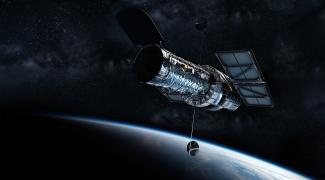The Dire Effects of Space Pollution
The environment got a big boost last September when a rocket blasting off from Vandenberg Air Force Base orbited Landsat 9. The new satellite is a highly instrumented space probe designed to scrutinize the Earth from aloft with visual images and an array of other sensors. Test photos taken shortly after launch showed outstanding resolution of the biosphere unrolling below.

Sadly, Landsat 9 and thousands of other useful satellites just above the atmosphere are an endangered species, threatened by their very number and by the detritus of orbital operations called space junk — at first, lost wrenches used by astronauts and globs of their frozen urine, but now increasingly the shards of crashed satellites.
Worryingly, the number of satellites has doubled in the last two years and that growth is accelerating; the increasing effluvia caused by resulting crashes could create a runaway chain reaction. Scientists call this a Kessler Syndrome — a hypothetical cascade of collisions flooding space with projectiles that then take out other satellites, until nothing is left in the valuable Low Earth Orbit zone but menacing chunks of metal and plastic. Space junk is already damaging vital satellites, even endangering astronauts on the International Space Station.
Society would suffer from this loss of a priceless resource in countless ways, including its ability to discover and manage global hazards. Much of environmental protection depends on information gathered by Landsat 9’s predecessors and other orbiting platforms. For instance, scientists use data gathered by satellites to feed into their climate models. These probes detect everything from the chemical composition of the atmosphere to the extent of Arctic sea ice, the thickness and annual runoff from the Greenland icecap, the calving of Antarctica’s floating ice sheets, the rate of recession of melting glaciers in temperate latitudes, and the rise of sea levels.
That’s not all. The ozone hole was discovered by satellites, which continue to monitor progress as the polar stratosphere heals. Orbiting probes also monitor oceanic dead zones, forest cover, and topsoil loss. Satellites detected the spreading of deserts in northern Africa and the extent of illegal forest clearing in Amazonia and Indonesia. And wildfires are tracked from orbit.
An outfit called Planet.com has 200 Earth-imaging satellites, providing almost real-time photos updating the entire Earth’s surface down to three-meter resolution every 24 hours. These data enable scientists to track everything from the loss of mangroves to unregulated emissions from smokestacks. Activists can employ Google Earth, a free utility, to monitor land use in their neighborhood. Farmers use GPS signals, also free, to navigate their giant cultivators and reduce runoff by applying chemicals judiciously. Package delivery companies use GPS to minimize gasoline usage. A proposed probe called MethaneSat would monitor the thousands of sites emitting that virtually uncontrolled greenhouse gas.
And of course consumers benefit from satellites in Low Earth Orbit. Our smartphones receive GPS signals. Several companies offer satellite phones that can be used anywhere on the planet, communicating through a constellation of dozens of orbiting repeaters skimming just above the atmosphere. And Elon Musk’s Starlink is launching thousands of small satellites that collectively will bring the internet to every part of the globe. There are already a total of 4,000 active satellites of all kinds. But there are numerous dead ones, and space agencies track 23,000 objects larger than a softball, any of which can take out a prized orbital platform.
So who would jeopardize such a useful resource? It’s an important question, because Low Earth Orbit is a largely unregulated arena that is legally the common heritage of humanity. As such, it is suffering from a tragedy of the commons, Garrett Hardin’s locution for how a resource can disappear without proper regulation, as users scramble to gobble up what they can.
Even worse, global superpowers are militarizing orbit, skirting the sense of the 1967 Outer Space Treaty that enjoins stationing weapons in orbit or on bodies in the solar system. In 2007, China demonstrated a missile that can take out a satellite, proving what it can do to enemy probes during warfare. Then last November, Russia did the same thing. The thousands of chunks blasted off by such tests are traveling at thousands of miles per hour, spraying Low Earth Orbit with dangerous projectiles in all directions.
The Liability Convention of 1972 adds to the space treaty some ground rules on collisions between satellites, where there is damage and fault, but it would be difficult to apply to the resulting pollution of space, as stray pieces caused by crashes take out other satellites and create more pieces in a Kessler episode. And it primarily enjoins nation-states, not private actors. A possibility here is a Superfund-like tax on all launches, with the money collected devoted to cleaning up space junk. Additionally, we could extend environmental impact assessment to space. Finally, a multinational body could be created to divide up Low Earth Orbit among competing countries and companies in a manner similar to how the International Telecommunications Union assigns the limited slots much higher up in geostationary orbit.
This blog originally appeared in the January/February 2022 issue of The Environmental Forum and is republished with permission.
